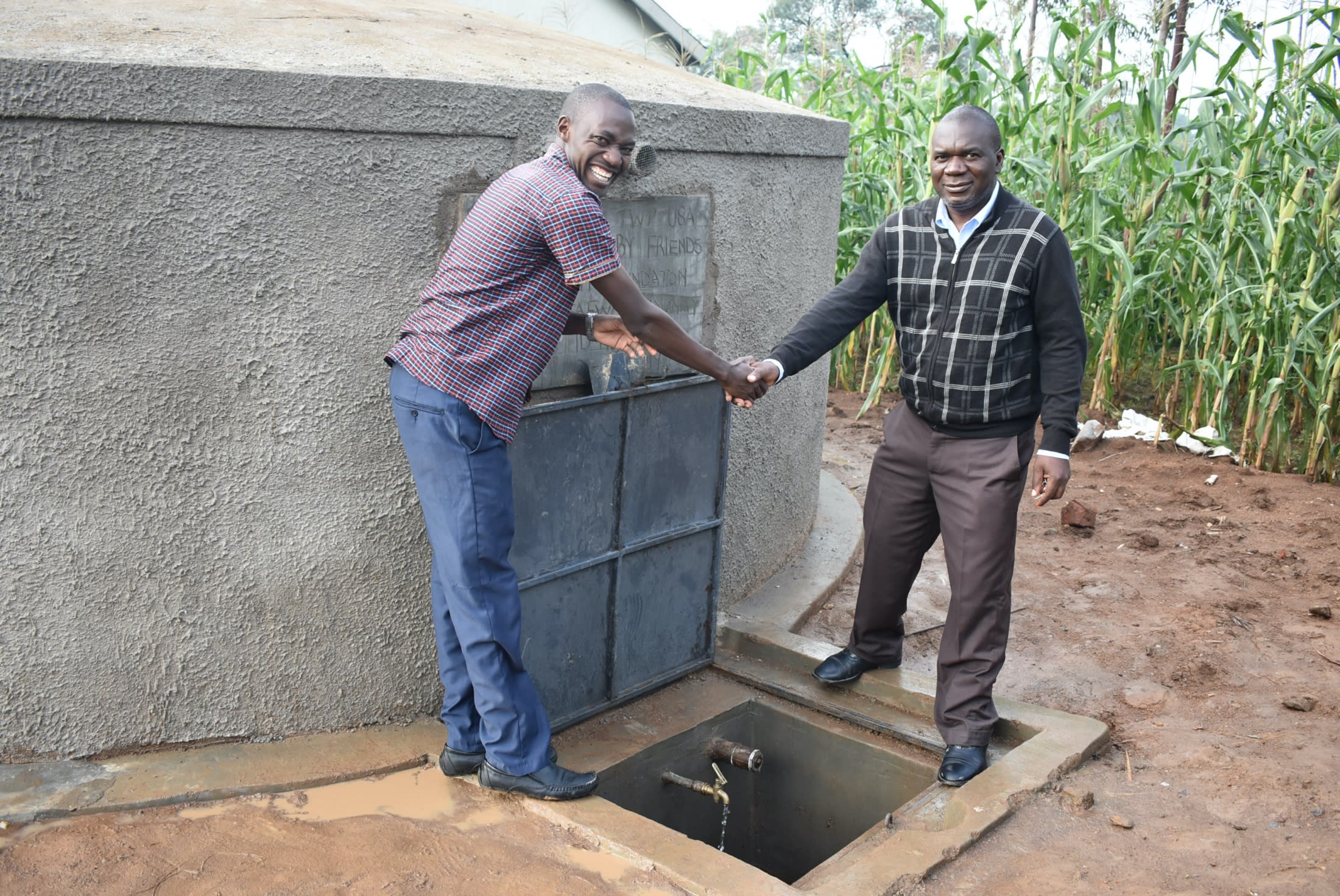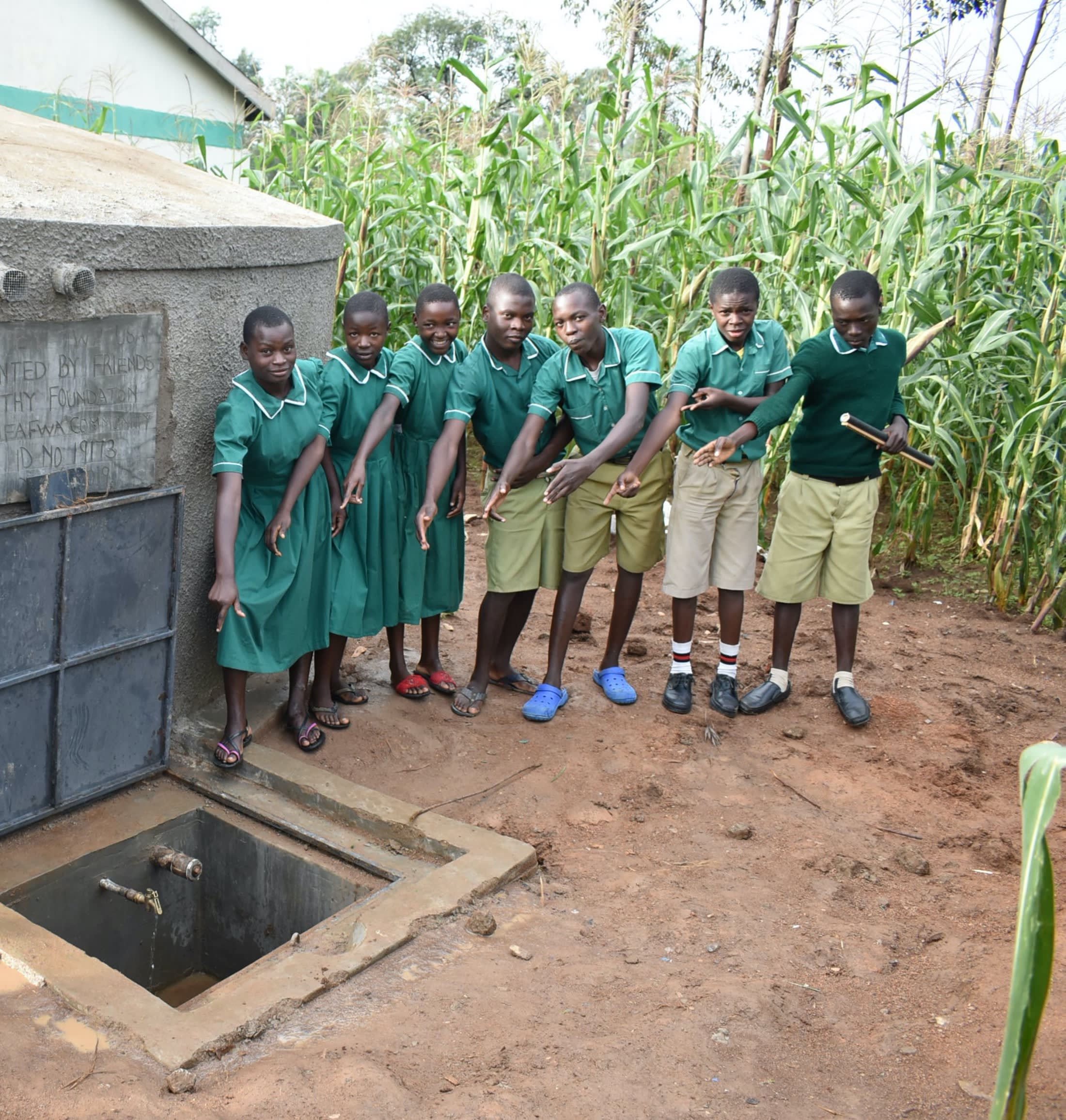November, 2019: Elufafwa Community School Project Complete!
Elufafwa Community School in Kenya now has access to a new source of safe, clean water thanks to the completion of their rain tank, which has the ability to collect 50,000 liters of water. We installed new latrines for students, handwashing stations, and we trained students and staff on improved sanitation and hygiene practices. All of these components work together to unlock the opportunity for these students to live better, healthier lives.

Celebrating unity over the new rain tank
Rain Tank
Construction for this 50,000-liter rain tank was successful!
Parents, staff, and students helped our artisans gather everything needed for construction. Students carried bricks to school and helped deliver water for the artisans' construction needs throughout the process.

Students help gather bricks for construction
The parents especially could not hide their happiness, for the contribution of locally available materials was done with ease and they were glad to be bringing food to the artisans while the project was under construction. They wanted to be involved directly into this project. All the while, the school provided accommodations for the artisans during their work. Local women and men helped our artisans with their manual labor, too.
The construction process officially began with our staff and school administration looking around the school compound to try and determine the best location for a new rain tank. This needed to be the best site with good, clean roofing to catch the rainwater.
Then, we cleared the site: excavating the soil within the required measurements to make level ground for the tank foundation. The foundation was cast by laying hardcore on level ground and then reinforcing it using steel, concrete and waterproof cement.

Pouring the rain tank's concrete foundation over wire and stones
Both the drawing pipe as well as the washout pipe were affixed as the foundation was laid. The wall was built with ferro-cement techniques through 6 layers. The inner wall was plastered while rough casting was done on the outer part. Finally, the catchment area was dug, plastered, and a staircase installed.

Plastering inside the rain tank
Dome construction could begin after the superstructure had been given enough time to settle. The manhole cover was fitted, inlet pipes were connected to the roof gutters, inlet screens, ventilation pipes (breathers) and overflow pipes were all done to standard.

Working on the dome
There were no challenges due to all of the local materials being provided on time. The cooperation from the school administration and even the students' hard work enabled the construction to be completed before the scheduled time. Once finished, the tank was given 3 to 4 weeks to undergo complete curing before it was cleaned and handed over to Elufafwa Community School, though we will continue to offer them unmatchable support as a part of our monitoring and maintenance program.

Officially handing over the rain tank to the school
The celebration was a great chance for us to acknowledge the school administration and students as the primary parties entrusted with the tools we’ve given, as well as remind them of our continued support as they develop. The project was handed over to the school management after completion. The head teacher together with Board of Management were present and received the project with happy faces.

Look! Clean water!
The school said the problem of time wasted going out of the school to fetch water was now over. They promised to take proper care of the facilities to ensure that they were able to serve them effectively. The head teacher, who has benefited from the same project done by our team at a different school before being transferred to Elufafwa this year, said he knew the benefits of such a project and he was very glad that we have put a smile on his face since the benefits will continue.
"Thank you...the project is Godsend. I was just wondering how I will run the school having gotten used to the same project in my former school", he said, but now he no longer has to wonder.

Students proudly show off their jugs of clean water collected from the tank
According to the school's administration, drinking water will be drawn every morning and put into their LifeStraw filters so that each pupil can access clean and safe water without struggling. Water for cleaning classes and kitchen use is to be drawn by only the authorized people within the school compound, primarily the school staff or supervised students. The tap will remain lockable and only be used when need be.

All smiles at the rain tank
"The availability of water in the school compound will save us time from going to fetch water at the spring outside the compound. We will now have more time for studies," said 12-year-old student Janet Omuhaka.
VIP Latrines
This project funded the installation of 6 new ventilated improved pit (VIP) latrines, half for girls and half for boys.

Boys get silly in front of their new latrines
All of these new latrines have cement floors that are designed to be easy to use and clean. And with a rain tank right on school property, there should be enough water to keep them clean.
Handwashing Stations
The 2 handwashing stations were delivered to the school and handed over to the student health club. These were placed outside of the girls’ and boys’ latrines to encourage handwashing after latrine use.

Girls line up for handwashing outside their latrines
Health club members teach other students how to properly wash their hands at the stations, make sure the stations are filled with water, and work to ensure that there is always soap or ash available.
New Knowledge
Hygiene and sanitation training was scheduled with the help of the school principal and Health Teacher Mr. Sylvester Ngaira, who together ensured that the training date would be convenient for students, staff, and parent representatives. Individual teachers helped by selecting students from each class to represent the others.
26 students attended the training, which was held in a classroom. The students chosen for the day participated actively and were very eager to learn. We covered a number of topics, including personal hygiene such as bathing, oral hygiene, and handwashing with soap as a barrier from germs; and operation and maintenance of the new facilities, with each person understanding their role for long-lasting clean water and good health. The new student health club will be greatly involved in project management and will be responsible for encouraging good health and hygiene practices amongst their peers, teachers, and the larger community.

Students actively participate during training
During the Leadership and Governance session, the trainer asked the students to state the characteristics of a good leader. They stated characteristics like being humble, obedient, proud, and hardworking. After some group work and discussion on this topic, the facilitator was able to mention the roles of the leaders that would be elected for the student health club. The trainer encouraged the club to be innovative and to come up with a project which will fetch them some income to run the club. The health teacher Mr. Ngaira promised to help the club be active and attain some savings by utilizing the school farm, whereby they could sell produce back to teachers for some coins.

Handwashing training
Later, the learners were mesmerized by the 10 handwashing steps. The facilitator began by asking the learners critical times when they wash their hands. The pupils mentioned times like before eating, after using the latrine, before fetching water, after doing any work, before going to school, and after playing football. The trainer then took the pupils through the 10 handwashing steps and the pupils were so excited to practice them.
One student named Fidelis, however, was disturbed with the 10 steps. He said that following all the steps will consume a lot of time. The trainer countered Fidelis by explaining that after frequent proper handwashing, anyone will get used to the steps and it will be easier for one to use the steps than not. The trainer also said that using the 10 handwashing steps will ensure thorough cleaning of the hands, helping to reduce the spread of bacteria and diseases.
"[I] am so grateful for this training. From now on I [will] start washing my hands more frequently," said 12-year-old student Christian Onami.

Trainer Joyce demonstrates handwashing
Overall the pupils had a passion for practicing all they had learned to ensure they utilize the knowledge gained. We believe they will put into use the things that were taught with the help of their very vibrant and active health teachers.
Mrs. Valentine Octioli was one of the health teachers who was very much excited about the training. She expressed her gratitude by promising to keep the student health club intact and active in the school compound. She promised to start a microfinance project in the school compound which will benefit the student health club members and the entire school.
The learners promised to take the lead in ensuring the project is sustainable.

A young student at the rain tank
Thank you for making all of this possible!


 Rainwater Catchment
Rainwater Catchment
 Rehabilitation Project
Rehabilitation Project





































